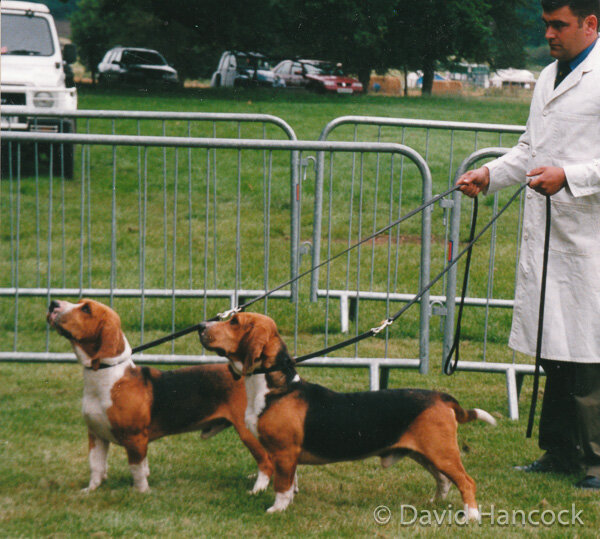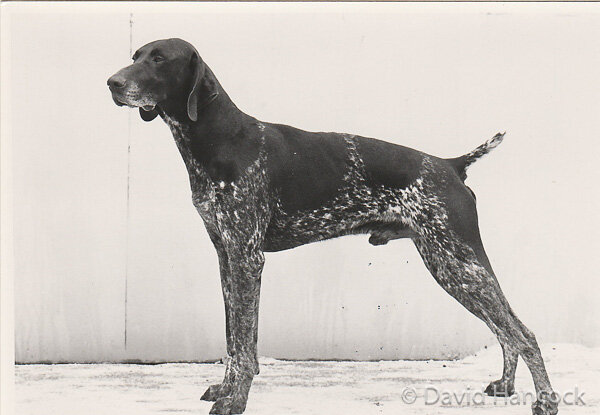1189
DOGS EXTENDED – BUT NOT FOR THEIR GOOD
By David Hancock
The most misunderstood phrase in the KC-issued Breed Standards for pedigree breeds recognized by them is ‘should stand over a lot of ground’. This phrase has a number of rivals for being poorly-understood but it is the one that does the most structural harm to breeds, sporting dogs especially. The best-bred sporting breed in Britain is undoubtedly the Foxhound of the packs, rivalled only by the Harrier. Both breeds, although differing pack-by-pack, are the ones most tested in their desired function. I have never seen one stand with its hindfeet way back beyond its root of tail. But I see any number of gundogs with this wholly undesirable feature in the show-rings and they look weak in the loins and unlikely to bear the weight of their hind-ends with their extended feet. It does nothing for their ‘gallop’, weakens their power of propulsion from the hindlegs and puts needless pressure on their spines. This is very much a modern fad; I never saw this fault in gundogs exhibited in the 1960s and 70s. The foreign gundog breeds are the worst offenders; if this flaw becomes encased in their breeding pools, then I see widespread anatomical disabilities cropping up, particularly in older dogs. It is a totally-undesirable, extremely-harmful fad. No breed of dog deserves such an affliction. I am disappointed that our vets aren’t speaking up about it.
But in every decade, in the world of the pedigree dog, the faddists are at work, sadly in far too many breeds. German Shepherd Dogs, in the days when they were still called Alsatians, were famed for their level toplines and their ability to maintain that topline on the move. The saying was that a glass of water placed on the back of an Alsatian would not be spilt when the dog moved. In more recent times we have banana-backed German Shepherd Dogs valued for their ability to 'gait' at speed whilst apparently lacking the capability to walk soundly. The back-end of the GSD has been undermined by misguided modern breeders. Bulldogs were once actually prized for being 'out at elbow', for having ludicrously barrel-chested rib cages and relatively gigantic heads. Now they seem to be prized for being just about muzzle-less. The giant breeds are often desired to be too big, with health and soundness overlooked.
But the smallest breeds have suffered too. The disproportionate length of spine, allied to shortness and crookedness in the legs, in the Dachshund, the Basset Hound and the Skye Terrier has inflicted a host of anatomical defects on each breed. There are simple remedies close at hand in each of these exploited breeds: the Dachshund could be outcrossed to the bigger, leggier Dachsbracke - its ancestral brother, the Skye could become shorter in the back and higher on the leg from Dandie Dinmont Terrier or Cairn Terrier blood and the Basset Hound has already been significantly improved by the breeding of the English or Hunting Basset, through an outcross to the Harrier. This last outcross was achieved by the Basset packs and fiercely opposed by the show ring devotees of the KC-pedigree breed. Why should a show ring fad be allowed to threaten the health and well-being of sentient creatures like dogs?
Fads may be passing indulgences for fanciers but they so often do lasting harm to breeds. If they did harm to the breeders who inflict them, rather than to the wretched dogs who suffer them, fads would be more tolerable and certainly more short-lived. But what are the comments of veterinary surgeons who have to treat the ill-effects of misguided fads? In his informative book "The Dog: Structure and Movement", published in 1970, RH Smythe, a vet and exhibitor, wrote: "...many of the people who keep, breed and exhibit dogs, have little knowledge of their basic anatomy or of the structural features underlying the physical formation insisted upon in the standards laid down for any particular breed. Nor do many of them -- and this includes some of the accepted judges -- know, when they handle a dog in or outside the show ring, the nature of the structures which give rise to the varying contours of the body, or why certain types of conformation are desirable and others harmful."
Having watched the judging at recent Crufts on Working Group Day, I can see why such words were forthcoming. Having gone to my first dog show well over sixty years ago, I feel, with enormous concern, that things are getting worse rather than better. In his book, Smythe goes on to say that "...the same may sometimes be written regarding those whose duty it is to formulate standards designed to preserve the usefulness or encourage the welfare of the recognised breeds." Encouraging the welfare of the recognised breeds has to be the underlying mission of not just the Kennel Club, whom Smythe is pointedly criticising, but every breeder, every breed club and every judge officiating at dog shows. The relentless pursuit of a muzzle-less Bulldog by contemporary breeders leads to distress in the dog. The vomer bone in this breed may be incomplete or more deeply notched at its front end than is desirable and this interferes with the suspension of the soft palate, giving rise to difficulty in breathing, especially in hot temperatures. This condition is often compounded by faulty development of the sphenoid bone, increasing the discomfort to the dog. At the World Dog Show a couple of years ago I saw a Bulldog collapse in the ring on a really hot day, be carried out of the ring by its handler, wrapped in cold wet towels for a while and then brought back into the ring, only to collapse again. Does such a person really love Bulldogs?
The gundog breeds carry surprisingly heavy items of shot game in their mouths using their temporal muscles ahead of their masseter muscle. This results in a soft mouth. Marked cheek development is undesirable in any gundog breed if the soft-mouthed virtue is to be retained. But I see many Labradors with the head and cheek muscles of a Rottweiler. I doubt very much if such a Retriever also displays a soft mouth. I worry too about some gundog breeds beginning to feature too deep a stop; cleft palates and very deep stops all so often go together. Why seek a feature which can harm the dog?
The jaws of so many breeds have fallen victim to thoughtless show points or perhaps breed points not thought through. Breeds ranging from the Poodle to the Chihuahua now have too narrow a jaw, too narrow that is to find space for the correct number of teeth. Conversely, broad-mouthed breeds like the Bulldog and the Boxer frequently display too many incisor teeth in both lower and upper jaw, as nature fills the unnatural width of mouth. Outward appearance impresses, the judge but a faulty mouth does the possessor no good at all. Internal soundness is mainly a moral issue for breeders, but it also needs special attention from the more perceptive judges.
We can stretch the jaw in width and length and the dog can still live a reasonably happy life. But when we seek to 'stretch' the hindquarters the consequences are much more worrying. We are then affecting the dog's ability to move as well as the best interests of its bone structure. Why does a show Greyhound need extensive angulation in the stifle when a successful coursing Greyhound used to triumph without it? Why do some HPR breeds suddenly need different hindquarters from all their ancestors? Why, for example, should the Weimaraner need longer upper hind legs than the other 'hunt, point and retrieve' breeds?
Inequality between the length of the rear stride and the length of the front stride is producing ugly unsound movement in an ever-increasing number of breeds as the contemporary fad for hyper-angulation in the hindquarters gathers more and more momentum. In the Dachshund the hind feet have difficulty keeping tally with the front ones. This, combined with inflexibility in the spine, produces a failure of synchronisation behind. In soundly-constructed dogs sufficient angulation in the hindquarters and adequate length in the tibia enables the hock to flex and the hind foot to advance beneath the body enough so that balance is maintained. The side effects of excessive angulation in the hindquarters of a number of pedigree breeds are increasingly manifesting themselves. Why then is it becoming almost 'de rigueur' in breeds like the Boxer, the Dobermann, the show Greyhound, the Great Dane and the show Whippet?
In every animal walking on four legs, the force derived from pressing the hind-foot into the ground has to be transmitted to the pelvis at the acetabulum, and onwards to the spine by way of the sacrum. In over-angulated dogs the locomotive power is directed to an inappropriate part of the acetabulum. In addition, so as to retain the required degree of rigidity of the joint between the tibia and the femur, other muscles have to come into use. In the over-angulated hind limb, the tibia meets the bottom end of the femur at such an angle that direct drive cannot ensue. The femur can only transmit the drive to the acetabulum after the rectus femoris muscle has contracted, enabling the femur to assume a degree of joint rigidity when connecting with the tibia. This means that the femur rotates anticlockwise whereas nature intended it to move clockwise.
Excessive angulation in the hindquarters, with an elongated tibia, may, to some, give a more pleasing outline to the exhibit when 'stacked' in the ring. But, in the long term, it can only lead to anatomical and locomotive disaster. Such angulation destroys the ability of the dog's forelimbs and hindlimbs to cooperate in harmony in propelling the body. Yet I have heard it argued by breed specialists at seminars that it will increase the power of propulsion operating through the hindlimbs and on through the spine. If it did, the racing Greyhound fraternity would have pursued it with great vigour. I have heard a dog show judge praise an over-angulated dog because it 'stood over a lot of ground'! So does a 'stretched limousine' but it requires a purpose-built construction to permit the luxury.
For those who care about dogs and love their breed, physical soundness, the ability of each dog to lead a happy life and the future of the breed thankfully matter more. Freud wrote that dogs love their friends and bite their enemies, quite unlike people, who have to mix love and hate in their object relations. Shakespeare's words "...he hates him that would ...stretch him out longer" may need amending in the canine context here. But if exhibitors love winning and hate losing, then seek to please ignorant judges, the effect is the same: their dogs risk being harmed. Would I be stretching a point if I pleaded for the 'stretched limousine' of the dog world to be only ‘through traffic’ - a passing phase?
























